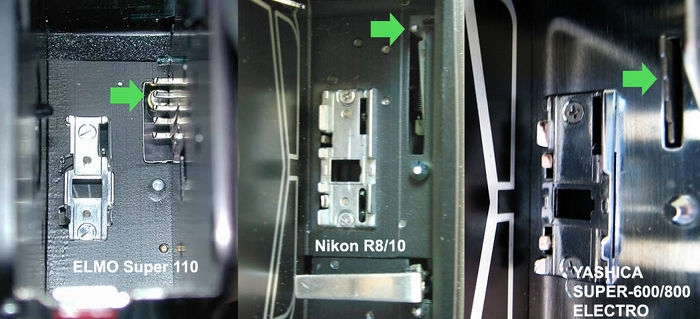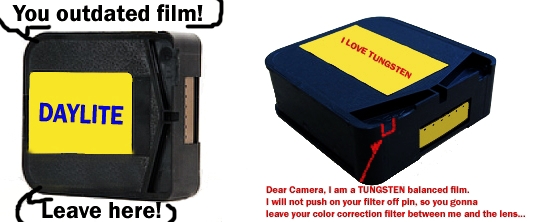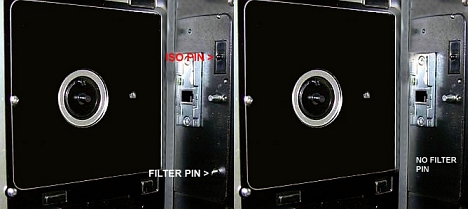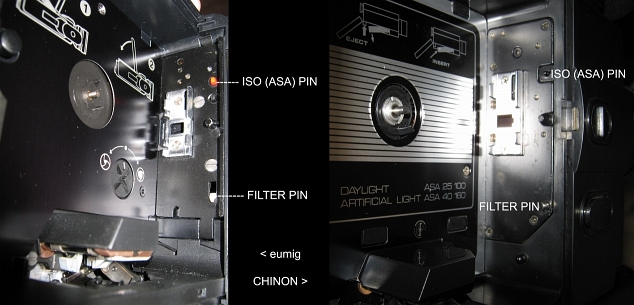Super 8 EKTACHROME 100D motion picture film exposed in old cameras
Important: This article only deals with Kodak's original EKTACHROME 100D Color Reversal Film 7285 (Exposure Index (EI): 100 ASA/ISO - DAYLIGHT BALANCED)! Other cartridges also contain Ektachrome 100D, e.g. "WittnerChrome 100D" or "Pro8mm Super-8.85", but they might cause other problems as they might be notched differently.
 < If your camera has one of these ISO pin systems, you are lucky, because they can meter almost all film stocks correctly!
< If your camera has one of these ISO pin systems, you are lucky, because they can meter almost all film stocks correctly!
Please note that ASA is an old term while the new one is ISO. Every camera should have the ISO PIN in order to know the speed of film emulsion for auto exposure. Some have pins some have different solutions for this, but they function in same manner. ISO PIN and FILTER PIN are different things and not connected to each other!
- The automatic exposure system of most Super 8 cameras can read the notches properly and will meter correctly. Any camera that is capable of correctly detecting the 100 ASA Daylight/160 ASA Tungsten film speed and is having a filter push pin (aka automatic release or Daylight filter-off pin) for the Daylight/Tungsten notch system (detecting the notch system on the Super 8 cartridge) should have no problem. In this case, the filter slider switch on the camera body (Sun/Bulb selection) has no function, if any!
- If the camera has no filter push pin, you should manually switch your camera filter selection slider to Bulb position (otherwise it will underexpose your film, and cause different color results than expected as well!)
Consult the camera manual, or better use this Super 8 Cartridge Notch Ruler to inspect the system used in your camera.
 < Some filter slider switches - Last picture shows the filter key (Kodak) system unique to some cameras.
< Some filter slider switches - Last picture shows the filter key (Kodak) system unique to some cameras.
However in a few cameras the EKTACHROME 100D might cause the following problems, here is an overview:
Contents
- 1 Cameras, that can meter properly
- 2 Cameras without any lightmeter
- 3 Cameras, that will treat the film as "40 ASA Tungsten"
- 4 Cameras, that will treat the film as "160 ASA Daylight"
- 5 Cameras, that will treat the film as "160 ASA Tungsten"
- 6 Cameras that ignore the "daylight/tungsten"-notch and that will therefore treat all "100 ASA Daylight"-films as "160 ASA Tungsten"-films
- 7 How to deal with these problems
Cameras, that can meter properly[edit]
These cameras should measure the notches properly and expose Ektachrome 100D correctly (But keep in mind that you might have to manually disable the camera's internal "daylight-filter" in most cases. Also keep in mind that some cameras can close their iris only to f-stop 16. This might be a problem on a sunny day that has to be solved with an ND [Neutral Density] filter.) ND.3 or ND 2X (1 stop), ND.6 or ND 4X (2 stops), ND.9 or ND 8X (3 stops):
- Canon 814/1014 XL-S
- Canon 814 Autozoom Electronic/1014 Autozoom Electronic
- Canon 814 XL
- Canon 814 Autozoom
- Canon 512 XL Autozoom Electronic
- Canon 518 Autozoom
- Canon 1218 Autozoom
- Canon 310 XL (but not Canon AF 310 XL/AF 310 XL-S)
- Bauer C Royal 6/8/10 E
- Bauer C 107/109/S 204/S 207/S 209 XL
- Bolex 150 Super/155 Macrozoom/160 Macrozoom
- Bolex 250
- Bolex 233 Compact
- Bolex 7.5 Macrozoom
- Bolex 580 Sound/581 Sound Macrozoom (but not 581 XL Sound)
- Elmo Super 103/103T (however these cameras suffer from the "f-stop 16"-problem!)
- Elmo Super 104/106/108/110
- Eumig Viennette 5
- GAF ST/111E/ST 802/ST 1002
- Minolta Autopak 8 S6
- Nikon (All models)
- Nizo 1048/2056/3048/4080/6080/481/561/801/Professional
- Porst ZRS 448 Reflex
- Ricoh 800Z
- Yashica SUPER-600 Electro and SUPER-800 Electro
- Sankyo CM series
- Sankyo CME series
- Sankyo MF series
- Sankyo LXL series
- Sankyo EM 40 and 60 XL
- Sankyo 420 and 620 XL
- Zeiss Ikon Moviflex S 8
- Zeiss Ikon Moviflex MS 8 Electronic
- ...
Cameras without any lightmeter[edit]
A few cameras only have a manual f-stop-setting and lack any lightmeter. Instead you'll find some scales printed/glued onto the camera. However their scales are only suited for films with "40 ASA Tungsten" and/or "160 ASA Tungsten". Even worse: In some cases the scales aren't even in f-stops, but only shows symbols like "sunny", "cloudy", ... . So you'll have to create yourself a new scale for "100 ASA Daylight" and e.g. glue it onto the camera; care should be taken of the fact that with some of the cameras the internal filter can only be disengaged when the aperture is fully open:
Cameras, that will treat the film as "40 ASA Tungsten"[edit]
Some cameras will treat any film as "40 ASA Tungsten" as they'll ignore all notches, e.g.:
- Agfa Microflex Sensor
- Agfa Microflex 100 Sensor
- Agfa Microflex 200 Sensor
- Agfa Microflex 300 Sensor
- Astral T2 Electric Eye
- Eumig Mini
- Halina Super Eight
- Minolta Pocket-8 400
- Minolta Pocket Z-8
- Voyageur Super 8
- Zenit Quarz 1x8S-2 (The manual suggests to set the exposure dial to -1 to make the camera work properly with a 100 ASA film-stock. But don't forget to also set the filter-switch to "bulb"!)
- ...
Cameras, that will treat the film as "160 ASA Daylight"[edit]
Hint: When your camera is listed in this section, you should simply give the E100D a try as it's only a small difference that might still lead to okay or good results.
Some cameras will treat any film notched as "100D" as "160D" as the Kodak Ektachrome 160G was once notched this way, e.g.:
Some cameras will treat any film as "160 ASA Daylight" as they'll ignore all notches, e.g.:
- ... (The majority of these cameras have been ultra cheap and have been sold as toys for children. So probably wouldn't use such a camera any more any way.)
Cameras, that will treat the film as "160 ASA Tungsten"[edit]
Some cameras will treat any film as "160 ASA Tungsten" as they'll ignore all notches, e.g.:
- ... (The majority of these cameras have been ultra cheap and have been sold as toys for children. So probably wouldn't use such a camera any more any way.)
Cameras that ignore the "daylight/tungsten"-notch and that will therefore treat all "100 ASA Daylight"-films as "160 ASA Tungsten"-films[edit]
- Bolex 233 Compact S, Eumig Mini 2, Eumig Mini 3 Servofocus, Eumig Mini 3 Servofocus PMA, Eumig Mini 3 Zoom Reflex: filter key needs to be put in and camera run on the setting "+" (backlight correction); alternatively the actual filter in the light path to the film can be removed from its holder (but NOT the one in front of the light sensor!) and the camera can be run on normal setting with E100D, still having the option of backlight correction if needed.
- Eumig Mini 5: filter key needs to be put in and camera run on the setting "+" (backlight correction)
- Eumig Nautica: filter needs to be retracted (switch in the film compartment at the bulb symbol) and camera run on the setting "+" (backlight correction)
- Eumig Viennette 3: filter key has to be put into slit with lamp symbol turned to you + aperture correction set to + 0,5
- Minolta Autopak-8 D 6 will read the film as "160 ASA Tungsten" there is no filter pin detector. Increasing the aperture by 2/3 to 1 full fstop should help the camera compensate. The use of a Neutral Density filter is recommended!!!
- Sankyo EM-30 XL: Select the tungsten position with the filter switch to remove the filter and set the exposure manually increasing the exposure by 2/3 of a stop. Alternatively reduce the light into the metering turret with some ND material.
- Canon 310 XL AF and Canon 310 XL-S AF


